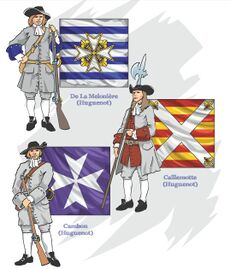Гугеноты
Материал из ВикиВоины
Гугеноты — французские протестанты, поднявшиеся во второй половине XVI века на борьбу с католической властью Франции, что привело к т. н. Французским религиозным войнам, которые также известны как Гугенотские войны.
Организация[править]
Less is known about the Huguenot army than about the king's because the documentation is scarce. But the two armies were bound to be similar, because the Huguenots had detached themselves from the royal army. Their command structure and numerical strength may have been different, but their fighting methods and weapons were basically the same. As the Huguenots held religious services in the open around 1560, they looked to their nobility for armed protection. Soon each Calvinist church was guarded by a captain and a force of specially-trained men. In November 1560, the Protestant synod of Clairac ordered the churches of Guyenne to begin organising military cadres and, in November 1561, the synod of Sainte-Foy in Upper Guyenne completed the task. Two 'protectors' were appointed, one each for the areas under the jurisdiction of the parlements of Bordeaux and Toulouse.
Colonels were chosen for each colloquy and captains to organise the forces of each church, in preparation for a renewal of persecution. The ministers at Sainte-Foy were ordered to oversee the musters. Eventually, this form of organisation was extended to every French province. The synod of Nimes in 1562 applied it to that area and other synods followed suit. So by 1562 a military infrastructure was already in place on which the Huguenot 'protector- general', the prince de Conde, could rely when he made his call to arms. The Huguenot forces were funded by gifts from Protestant churches, by property confiscated from Catholics and by tax revenues diverted from royal coffers. The army comprised cavalry and Infantry, like that of the king. The infantry companies were 100 to 150 men strong. Only about one-fifth were pikemen; the rest were arquebusiers. By 1562 it seems that some companies were made up entirely of arquebusiers. The nucleus of the heavy cavalry consisted of four companies of the king's army, who went over en masseto the Huguenot side - in 1562 Francois d'Andelot, colonel-general of the king’s infantry, defected to the Huguenot side, bringing with him his loyal clientele. The rest of the army were volunteers raised by the Huguenot leaders among their friends and dependents.
Галерея[править]
Источники[править]
- https://ru.wikipedia.org/wiki/Гугеноты
- Osprey — Essential histories 047 — The French Religous Wars 1562-1598 — P.28.


